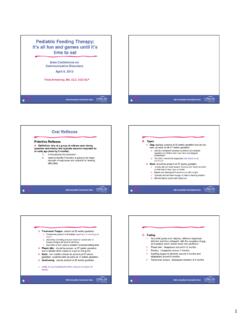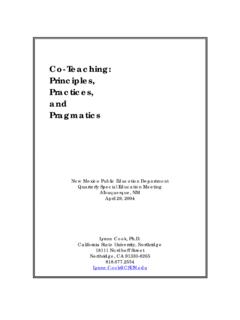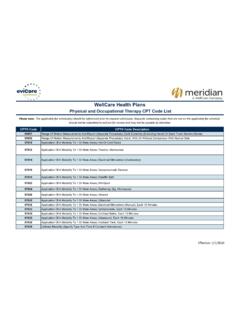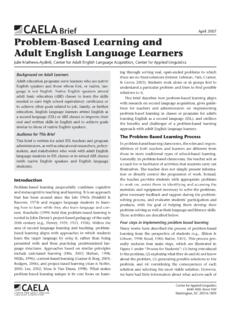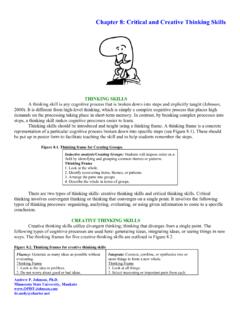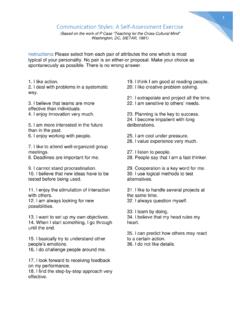Transcription of Standardized SLP Testing Instruments List
1 Standardized SLP Testing Instruments List ( ) Assessment Resource Age Description/ Contents Bracken Basic Concept Scale: Expressive (BBCS:E) 3 to 6 years Screen concepts of color, letters/sounds, numbers/counting, size, shape, direction/position, self/social awareness, texture/materials, quality, and time/sequencing. Bracken Basic Concept Scale: Receptive 3 to 6 years Evaluate the acquisition of basic concepts of a child, which is strongly related to cognitive and language development as well as early childhood academic achievement. CELF-P Clinical Evaluation of Language Fundamentals-Preschool Pre-school to early elementary aged children Subtests include basic concepts, sentence and word structure, formulating labels, recalling meaning, and linguistic concepts.
2 CELF-4 Spanish Clinical Evaluation of Language Fundamentals-4 6 to 21 years Evaluates a broad range of language skills such as linguistic concepts, formulating sentences, following directions, and listening to paragraphs. CELF-4 Clinical Evaluation of Language Fundamentals-4 5 to 21 years Evaluates a broad range of language skills such as recalling and formulating sentences, word classes, word definitions, understanding spoken paragraphs, semantic relationships, etc. CELF-5 Clinical Evaluation of Language Fundamentals-5 5 to 22 years The new CELF-5 is a comprehensive battery of tests that provides you with a streamlined, flexible approach to language assessment. It now offers a more robust assessment of pragmatics using observations and interactive activities.
3 CELF-5 Clinical Evaluation of Language Fundamentals Screening Test-5 5 to 22 years Quick, reliable, and easy to use;now includes a pragmatics screening. Children's Communication Checklist-2 ( Edition) 4 to 16 years Parent or caregiver rating scale for speech, syntax, semantics, coherence, initiation, scripted language, context, and nonverbal communication. Communication Abilities Diagnostic Test (CADeT) (Johnson) 3 to 9 years Tests various language performance in syntax, semantics and pragmatics during story, game, and conversational situations. Comprehensive Assessment of Spoken Language (CASL) 3 to 21 years Assesses language processing skills and knowledge. Comprehensive Receptive & Expressive Vocabulary Test (CREVT) (Wallace and Hammill) 4 to 18 years Measures both receptive and expressive vocabulary using common standardization for both areas.
4 Criterion Referenced Inventory of Language (Wiig) 4 to 13 years Extension Testing in the areas of semantics, pragmatics, morphology, and syntax. Emerging Literacy Language Assessment (ELLA) to 9 years Screens phonological awareness and flexibility; sign and symbol recognition and interpretation; memory, retrieval and automaticity. Evaluating Communicative Competence-Revised Ed. (Simon) 9 to 17 years Consists of 21 informal inventories encompassing language processing, metalinguistics, and functional use of language. Expressive Vocabulary Test, 2nd edition (EVT) (Williams) to 90 years Measures expressive vocabulary and word retrieval in standard English. Functional Communication Profile (Kleiman) 3 years to adulthood Facilitates compilation of skill level information from a variety of areas such as attentiveness, sensory/motor issues, speech, fluency, voice, and pragmatics/social skills.
5 Goldman-Fristoe 2 2 to 21 years Measures articulation of consonant sounds, determine types of misarticulation, and compare individual performance to national, gender-differentiated norms. Language Processing Test-Revised (LPT-R) (Richard and Hanner) 5 to 11 years Uses tasks for association, categorization, similarities and differences, multiple meanings, and attributes. The Listening Comprehension Test (Adolescents) 12 to 17 years Subtests require students to listen for a purpose such as main area, details, reasoning, vocabulary and semantics, and understanding messages. The Listening Comprehension Test 2 (Elementary) 6 to 11 years Assesses listening through natural classroom situations rather than evaluating listening through simple repetition or discrimination subtests.
6 MacArthur-Bates Communication Development Inventories (1-3) 3-37 months Three inventories to probe parent report on gestures, words, and sentence use. Montgomery Assessment of Vocabulary Acquisition (MAVA) 3 to 11 years Receptive/expressive evaluation of the 3 tiers of vocabulary-basic, high frequency and curriculum based. Oral and Written Language Scales (OWLS) (Carrow-Woolfolk) 3 to 21 years oral scale; 5 to 21 years written scale Assesses listening comprehension, oral expression, and written expression. Oral and Written Language Scales II (OWLS II) (Carrow-Woolfolk) 3 to 21 years oral scale; 5 to 21 years written scale Assesses listening comprehension, oral expression, and written expression. Peabody Picture Vocabulary Test 4 Form A (PPVT-4) to 90+ years Measures the receptive (hearing) vocabulary of children and adults.
7 Peabody Picture Vocabulary Test 4 Form B (PPVT-4) to 90+ years Measures the receptive (hearing) vocabulary of children and adults. pragmatic Language Observation Scale (PLOS) 8 to 18 years Designed to assess students' daily classroom spoken language behaviors. pragmatic Language Skills Inventory (PLSI) 5 to 12 years Designed to assess children's pragmatic language abilities. PLAI 2-Preschool Language Assessment Instrument (Blank) 3 to 6 years, but can be used with older children Probes for ability to label objects and actions, role-play, respond to conversational interactions, respond to directions, define words, solve problems etc. Preschool Language Scale, 5th ed (PLS5)(Zimmerman) Birth to 7 years Evaluates maturational lags, strengths, and deficiencies by Testing auditory comprehension and verbal ability.
8 Rice Wexler Test of Early Grammatical Impairment 3 to 8 years Uses manipulative tasks and pictures to assess early morphemes and sentence structure. Screening Test for Developmental Apraxia of Speech, 2nd edition (STDAS-2) 4 to 12 years Identifies children with atypical speech-language problems and associated oral performance. Social Language Development Test Elementary 6 to 11 years Assesses language-based skills of social interpretation and interaction with friends, the skills found to be most predictive of social language development. Social Language Development Test Adolescent 12 to 17 years Assesses students' language-based responses to portrayed, peer-to-peer situations. Test de Vocabulario en Imagenes Peabody (TVIP) to 18 years Contains 125 items from PPVT-R to assess vocabulary of Spanish speaking and bilingual children.
9 Test for Auditory Comprehension of Language-3 (TACL-3) (Carrow-Woolfolk) 3 to 10 years Measures receptive spoken vocabulary grammar, and syntax. Test for Auditory Comprehension of Language-4 (TACL-4) (Carrow-Woolfolk) 3 to 10 years Measures receptive spoken vocabulary grammar, and syntax. Test of Adolescent Language-4 (TOAL-4) 12 to 24 years Tests domains of vocabulary and grammar in areas of listening, speaking, reading, and writing. Test of Adolescent/Adult Word Finding (TAWF) (D. J. German) 12 to 80 years Evaluates picture naming of nouns and verbs, sentence completion naming, description naming, and category naming. Test of Aided Communication Symbol Performance (TASP) Children through adults Provides starting point for AAC intervention by screening symbol size and number of items, grammatical encoding, categorization, and syntactical performance.
10 Test of Early Language Development-3 (TELD-3) 2 to 8 years Examines receptive and expressive language. Test of Language Competence-Levels 1 & 2 (Wiig and Secord) to 10 years Level 1; 9-19 years Level 2 Evaluates metalinguistic performance in the areas of semantics, syntax, and pragmatics. Test of Language Development-Primary 4th edition (TOLD-P:4) 4 to 9 years Evaluates children's spoken language ability within a semantic, grammatic, and phonological context. Test of Narrative Language 5 to 11 years Measures ability to answer comprehension questions and ability to generate a story. Test of pragmatic Language: 2 (2nd ed. of TOPL) 6 to 18 years Assesses knowledge about situational social interaction; also contains a metacognitive pragmatic evaluative component.
